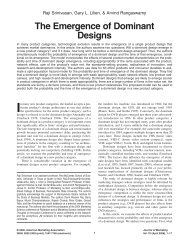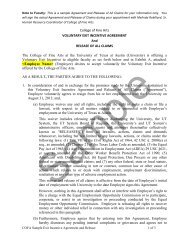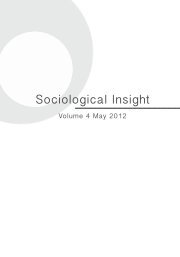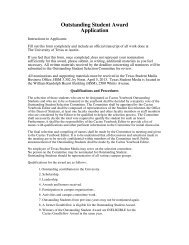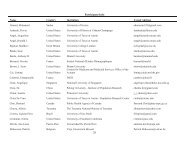Invited Talks: Transition Metal Oxides - University Blog Service - The ...
Invited Talks: Transition Metal Oxides - University Blog Service - The ...
Invited Talks: Transition Metal Oxides - University Blog Service - The ...
Create successful ePaper yourself
Turn your PDF publications into a flip-book with our unique Google optimized e-Paper software.
<strong>The</strong> John B. Goodenough Symposium in Materials Science & Engineering–<br />
In Honor of His 90 th Birthday<br />
<strong>The</strong> <strong>University</strong> of Texas at Austin, Austin, Texas<br />
October 26-27, 2012<br />
Perovskites of p-block elements: influence of the lone electron pair<br />
José-Antonio Alonso<br />
Instituto de ciencia de Materiales de Madrid, C.S.I.C., Cantoblanco, 28049 Madrid<br />
Email: ja.alonso@icmm.csic.es Website: http://www.icmm.csic.es/matfuelcells/<br />
Perovskite oxides containing p-block elements at the A positions provide the possibility of investigating<br />
the stereochemical effect of the lone electron pair on the crystal structure and properties of these materials.<br />
In this work we will address the singular features of two families of perovskites: Se(Te)MO 3 (M=<br />
Mn,Co,Ni) and Pb 2 (M,Sb)O 6 (M= rare earths). <strong>The</strong> former oxides are only accesses via high-pressure<br />
synthesis, given the small size of Se 4+ (Te 4+ ) and the extremely distorted MO 6 octahedral framework. <strong>The</strong><br />
irregular oxygen environment around Se(Te) is the result of the presence of the Se 4+ (Te 4+ ) non-bonded<br />
lone 4s 2 electron pair, which is thought to be directed towards the apex of each trigonal pyramid.<br />
Additionally, three short Se-O bond lengths, implying very covalent Se-O bonds in a trigonal pyramidal<br />
configuration, are an important ingredient for the stability of this family of SeMO 3 perovskites. <strong>The</strong> highpressure<br />
structural evolution also provides with clues to understand the nature of the chemical bond in<br />
these materials. <strong>The</strong> family of Pb 2 (M,Sb)O 6 oxides, typified by Pb 2 TmSbO 6 , exhibit a room-temperature<br />
structure never observed in double perovskites, and an original sequence of phase transitions with<br />
temperature; in the different structures an asymmetrical distribution of the chemical bonds driven by the<br />
strong interaction between the Pb 2+ non-bonded 6s 2 electron pair and the oxygen p states is observed,<br />
which has been visualized from the electron localization function obtained from DFT calculations by<br />
using accurate structural data for the room temperature crystal structure. Moreover, the presence of an<br />
unexpected hybridization between Y and oxygen has been observed in Pb 2 YSbO 6 . This behavior involves<br />
the oxygen atoms that form the PbO 4 polyhedron, suggesting a strong effect of the chemical pressure of<br />
the non-bonded electron pair of lead in the whole structure of these compounds.







